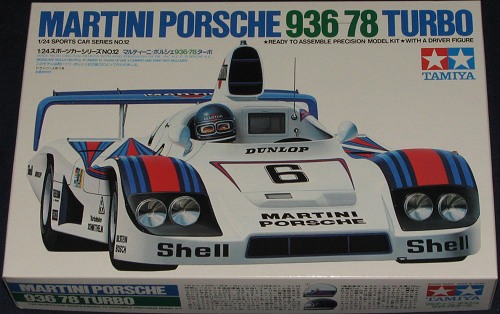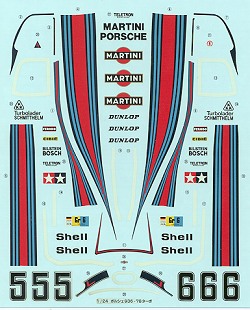
| KIT: | Tamiya 1/24 Porsche 936-78 Turbo |
| KIT #: | 24012 |
| PRICE: | Around $20-25 MSRP |
| DECALS: | Two options |
| REVIEWER: | Scott Van Aken |
| NOTES: | Curbside, molded in 2000 |

| HISTORY |
Almost from its inception, Porsche has been involved in auto racing. This stems from its founder's involvement in the pre-WWII Auto Union racing team with it's rear engined 12 cylinder engine. This car along with Mercedes dominated Formula One prior to the start of WWII and the cessation of motor sports in Europe.
When Porsche emerged with his own company after the war, they started building cars that were targeted to the enthusiast. Soon the engineering and quality of their products made Porsches the cars to have. This, in turn, made them very popular among sports car racers. Initially limiting their involvement to smaller displacement cars, Porsche gradually worked its way to where they were competing in the heavy-weight classes.
For sports cars and sports racers, THE event of the year is the 24 hour race at LeMans. This is a test of not only speed, but endurance. Porsche has generally had the endurance part of it pretty well down pat. The reliability of their cars is almost legendary. What was needed was speed. This was finally achieved in the early 1970s with their hulking 917 series that so dominated that it brought about rule changes making the cars no longer able to compete.
No matter as Porsche just developed new cars to take advantage of the change in rules. By the late 1970s, the rivalry in the sport (and there is always a rivalry), was between Porsche and Renault. The 1976 and 1977 events had been won by Porsche and they were going for three in a row in 1978. They fielded two brand new cars for the 1978 event, both of them open cars, the #5 machine driven by Jacky Ickx and Henri Pescarolo, and the #6 car piloted by Wolleck, Barth and Joest.
Both cars were plagued with turbo problems and the #5 car finally had to be parked. Ickx then took over from Joest in the #6 car while it was running fourth. During the night, Ickx astonished on-lookers by moving the car into second place. The other drivers were able to maintain the position while Ickx rested. Ickx then put up a masterful drive, nearly catching the leading Renault Alpine A443 Turbo, but transmission problems meant that he was never able to catch them and Renault won the race to the thrill of the partisan French crowd. Despite finishing second, Jackie Ickx's drive was one to remember and helped to further cement his reputation as one of the world's best sports car drivers.
| THE KIT |

 Those
of you who have been into cars for a while realize that Tamiya is one of
the best in this area. They generally don't do US cars or NASCAR stockers,
or Indy cars, leaving that to ERTL and Revell. Instead they concentrate on the rest
of the world, producing kits of Japanese cars we've never heard of and a
lot of racing cars; from rallye to Formula 1.
Those
of you who have been into cars for a while realize that Tamiya is one of
the best in this area. They generally don't do US cars or NASCAR stockers,
or Indy cars, leaving that to ERTL and Revell. Instead they concentrate on the rest
of the world, producing kits of Japanese cars we've never heard of and a
lot of racing cars; from rallye to Formula 1.
This is part of their Sports Car series; #12 in fact. The kit is a curbside, which means that there is no engine. The bottom part of the engine/transmission is molded onto the floor pan and this snaps in place under the body. You see, it is designed to be motorized and where the plastic engine would fit is taken up by mounts for the electric motor and its batteries.
The kit comes with rubber tires and metal axles which are held in place by poly caps. In order to fill up the driver's compartment, a scale driver figure is included in the regalia of the times. Instructions are excellent as one would expect from Tamiya. All the paints are referenced to their own paint line, though generic names are given. Decals are quite extensive, though not overly so, and provide markings for both cars. They are a bit thick and the white bits are actually ivory, but they should hold up well to all the pushing and adjusting that will be required to get them into place. I also note that there are no driver's names included, which is too bad.
| CONCLUSIONS |
Into racing cars? Then you'll like this one. The curbside aspect of the kit means not a lot of fiddly bits and since it is basically white, you could probably get away with not painting the body, though it would mean not filling the two sink areas just in front of the wing supports. Due to the design of the body, this would probably work well as a slot car body as well. It is a kit that those who are ready for a bit more than snap kits should enjoy building.
June 2005
If you would like your product reviewed fairly and quickly by a site that has nearly 300,000 visitors a month, please contact me or see other details in the Note to Contributors.